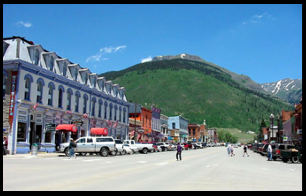Reports from the Knowledge Labs about our recent findings, research topics, and interviews with lifestyle leaders who are creating their own futures.
|
|
| |
How to stimulate your own powers of foresight. Consider the following thought provokers. Ask yourself, in these categories what are the brand new trends and forces? Which are the ones growing in importance? Which current forces are loosing their steam? Which have peaked or are reversing themselves? Which are the "wildcards" about to disrupt us in the future? POLITICAL AND TECHNICAL thought for food: Electronics, Materials, Energy, Fossil, Nuclear, Alternative, Other, Manufacturing (techniques), Agriculture, Machinery and Equipment, Distribution, Transportation (Urban, Mass, Personal, Surface, Sea, Subsurface, Space), Communication (Printed, Spoken, Interactive, Media), Computers (Information, Knowledge, Storage & Retrieval, Design, Network Resources), Post-Cold War, Third World, Conflict (Local, Regional, Global), Arms Limitation, Undeclared Wars, Terrorism, Nuclear Proliferation, Weapons of Mass Destruction, Governments (More/Less Power and Larger or Smaller Scale), Taxes, Isms: Nationalism, Regionalism, Protectionism, Populism, Cartels, Multinational Corporations, Balance of Trade, Third Party Payments, Regulations (OSHA, etc.) Environmental Impact, U.S. Prestige Abroad. SOCIAL AND ECONOMIC Food for thought:
Labor Movements, Unemployment / Employment Cycles, Recession, Employment Patterns, Work Hours / Schedules, Fringe Benefits, Management Approaches, Accounting Policies, Productivity, Energy Costs, Balance of Payments, Inflation, Taxes, Rates of Real Growth, Distribution of Wealth, Capital Availability and Costs, Reliability of Forecasts, Raw Materials, Availability and Costs, Global versus National Economy, Market versus Planned Economies, Generations: Y, X, Boomers, Elderly, Urban vs. Rural Lifestyles, Affluent vs. Poor, Neighborhoods and Communities, Planned or Organic Growth.
Got Knowledge?
|
|
| |
|
|
|
|
The Journal of 2020 Foresight
|
|
| |
|
Friday, November 22, 2002

New World Order, US Social Security Goes Belly Up
Chapter One: Basecamp
By Steve Howard, CKO
The Knowledge Labs
Table of Contents
Chapter One: Basecamp
Chapter Two: The Ridge
Chapter Three: The Outpost
Chapter Four: The Tribal Territories
Top one hundred trends: 100-91, 90-81, 80-71, 70-61, 60-51, 50-41
40 – Medicare, Social Security & interest absorb all tax revenues by 2012 triggered by the baby boom generation's retirement, which officially commences in 2008 (Heilemann)
39 – Social Security isn't set to go bust until 2029, its first cash-flow shortfall - i.e., when it starts ballooning the deficit - is forecast for 2008. (Heilemann)
38 – The developed world is in the midst of a once-a-century paradigm shift: from the old industrial order to the globally interdependent, knowledge-based economy in ascendance (Howard)
37 – From 1998 to 2008: small and large growth stocks will do well. Also emerging countries in the international sector (Dent)
36 – During this timeframe real estate and REIT funds look attractive (Dent)
35 – Dow will reach 21,500 around 2008 and the time to harvest stock and most real-estate investments (Dent)
34 – Shift into long-term treasuries and very high quality corporate bonds between 2006 to 2008. (Dent)
33 – In 2009 or 2010 expect the first serious U.S. and global stock correction and shift bond portfolios into Japanese and some European stocks. (Dent)
32 – From 2015 to 2023 look for long-term buying opportunities in exurban real estate, emerging countries, and U.S. small cap stocks. (Dent)
31 – Return to a classic investment portfolio allocated among large caps, small caps, real estate, international, and bonds beginning in 2020 or 2023. (Dent)
30-21
What’s your take?
Got Knowledge?
Copyright ©2002 - 2006 Aarnaes Howard Associates. All rights reserved worldwide.
7:14 AM
Monday, November 18, 2002

Overlay of Political and Technical Trends
Chapter One: Basecamp
By Steve Howard, CKO
The Knowledge Labs
Table of Contents
Chapter One: Basecamp
Chapter Two: The Ridge
Chapter Three: The Outpost
Chapter Four: The Tribal Territories
Top one hundred trends: 100-91, 90-81, 80-71, 70-61, 60-51
50 – A long-term commitment to a permanent military establishment grows (Cetron)
49 – Smart weapons may tend to reduce military personnel requirements (Cetron)
48 – Compulsory national service for 2 years is likely for males and females: military service, vista-type working with disadvantaged or peace Corps (Cetron)
47 – International affairs and national security as a major societal factor (Cetron)
46 – The integration of national and international economies (Cetron)
45 – U.S. balanced-budget efforts will force tradeoffs, e.g., space shuttle vs. food stamps vs. aid to education (Cetron)
44 – International trade cooperation will take precedent over national self-interest (Cetron)
43 – International economies will interact more on the world's stock exchanges (Cetron)
42 – Union membership will make up only 10% of the U.S. labor force (Cetron)
41 – Bimodal distribution: bigger get bigger, middle get squeezed, small survive (Cetron)
40-31
What’s your take?
Got Knowledge?
Copyright ©2002 - 2006 Aarnaes Howard Associates. All rights reserved worldwide.
6:25 AM
Thursday, November 14, 2002

The Rise of Agents and Athletes – Professional Knowledge Workers
Chapter One: Basecamp
By Steve Howard, CKO
The Knowledge Labs
Table of Contents
Chapter One: Basecamp
Chapter Two: The Ridge
Chapter Three: The Outpost
Chapter Four: The Tribal Territories
Top one hundred trends: 100-91, 90-81, 80-71, 70-61
60 – Self-employed people in the U.S. continue to grow at 4 times the rate of salaried workers. (Cetron)
59 – More mid-career professionals will opt for entrepreneurship from downsizing. (Cetron)
58 – Only 1 person in 50 will be promoted to top management in big companies (Cetron)
57 – 85% of workers will be working for firms with fewer than 200 people. (Cetron)
56 – Growth of self-managing specialists; input from colleagues, customers &
Headquarters (Cetron)
55 – In 2010 large businesses will have less than 50% the levels of management (Cetron)
54 – They'll operate with 33% of the number of managers. (Cetron)
53 – Subordinates will increase from 7 to 21 for each manager (Cetron)
52 – Advancements will be few; opportunities will be within narrow specialties
51 – Task-focused specialist will do the actual work. Traditional departments will assign specialists, set standards, and do training
50-41
What’s your take?
Got Knowledge?
Copyright ©2002 - 2006 Aarnaes Howard Associates. All rights reserved worldwide.
3:50 PM
Wednesday, November 13, 2002

Mass Customization Boom and Deflation for the Next Decade
Chapter One: Basecamp
By Steve Howard, CKO
The Knowledge Labs
Table of Contents
Chapter One: Basecamp
Chapter Two: The Ridge
Chapter Three: The Outpost
Chapter Four: The Tribal Territories
Top one hundred trends: 100-91, 90-81, 80-71
70 – Little or no inflation over the next decade, despite dramatic economic growth. (Dent)
69 – The next depression from around 2010 to 2025. (Dent)
68 – Many niche products from the past decade moving into the mainstream. This means changing leadership in most industries, threatening many established products and services. (Dent)
67 – A general preference for safety, clean air, privacy, and selective intimacy—a kind of "humanness"—will lead a migration trend from suburbs toward smaller cities, towns, and neighborhoods similar to the last generation's move from the cities to the suburbs. (Dent)
66 – The baby boom generation will demand more personalized, customized, high-quality products. (Dent)
65 – These demands will move business away from production of standardized products on the assembly line to delivery of specialized, personalized products and services produced at the front lines of organizations as close to the customer as possible. (Dent)
64 – Third of 3 boomer age segment waves drives a spending surge that won't peak until around 2006 to 2010 (Dent)
63 – There are two concentrated savings phases in the family life cycle, ages 35 to 44 and 50 to 74. Baby boomers will be moving strongly into this first range from the early 1990s into the early 2000s. (Dent)
62 – As savings increase, there will be more capital for our economy to invest This means a lower cost of capital for our businesses, which will make them more competitive and help encourage a longer-term view on capital investment again. (Dent)
61 – Labor shortages until 2015, automate for productivity (Dent)
60-51
What’s your take?
Got Knowledge?
Copyright ©2002 - 2006 Aarnaes Howard Associates. All rights reserved worldwide.
6:23 AM
Tuesday, November 12, 2002

Be Nice to Your Niece, You Might Make it to 100
Chapter One: Basecamp
By Steve Howard, CKO
The Knowledge Labs
Table of Contents
Chapter One: Basecamp
Chapter Two: The Ridge
Chapter Three: The Outpost
Chapter Four: The Tribal Territories
Top one hundred trends: 100-91, 90-81
80 – 70% of boomer women will outlive their husbands (Russell)
79 – On average baby boom women will be widows over a 15-year period (Russell)
78 – As a generation boomers will spend the rest of their lives trying to look young (Russell)
77 – About 33% of elderly boomers will have hearing problems (Russell)
76 – Heart disease, cancer and stroke will kill 70% of the boomers (Russell)
75 – 40% of old boomers will depend on friends & relatives for daily living chores (Russell)
74 – Many elderly boomers will be cared for by their nieces in old age (Russell)
73 – Boomers will be consumers of nursing home insurance (Russell)
72 – 20% of elderly boomers will be in a nursing home by the year 2045 (Russell)
71 – 1 million baby boomers will live to be 100 years old; the last will die in 2069 (Russell)
70-61
What’s your take?
Got Knowledge?
Copyright ©2002 Aarnaes Howard Associates. All rights reserved worldwide.
6:08 AM
Monday, November 11, 2002

A Hundred Trends on the Wall, If 10 of them Happen to Fall
Chapter One: Basecamp
By Steve Howard, CKO
The Knowledge Labs
Table of Contents
Chapter One: Basecamp
Chapter Two: The Ridge
Chapter Three: The Outpost
Chapter Four: The Tribal Territories
Top one hundred trends: 100-91
90 – The average career span for baby boomer males will be 33 years (Russell)
89 – Boomer women will work for an average of 24 years (Russell)
88 – Boomers will work at 10 different jobs during their career (Russell)
87 – Male boomer college grads will earn over $1 million in their life (Russell)
86 – Boomers will become speculators to increase their wealth (Russell)
85 – A new industry will be created to appeal to boomer need for experiences (Russell)
84 – In old age the baby boom will become more liberal (Russell)
83 – In the year 2010 American social consciousness will reawaken (Russell)
82 – Most baby boomers won't be able to save enough for a comfortable retirement (Russell)
81 – The boomers will spend 2 decades in retirement (Russell)
80 - 71
What’s your take?
Got Knowledge?
Copyright ©2002 Aarnaes Howard Associates. All rights reserved worldwide.
11:33 AM
Friday, November 01, 2002

Future Work: Social and Economic Drivers
Chapter One: Basecamp
By Steve Howard, CKO
The Knowledge Labs
Table of Contents
Chapter One: Basecamp
Chapter Two: The Ridge
Chapter Three: The Outpost
Chapter Four: The Tribal Territories
Journal of 2020 Foresight: So, you asked people from all walks of life – artists, lawyers, professors, human capitalists, IT professionals, executive management, marketing, finance, operations, sales, service, engineering – anyone and everyone -- to tell you which forces they foresaw in the future as having the most impact on their plans, right?
Pathfinder: That's right. In Basecamp, having already examined our current situation in light of past trends that influenced how well or how poorly earlier decisions panned out for our expedition members, we turned from the power of hindsight to the power of foresight.
Trailblazer: We simply asked a few questions to get the discussion going. What are the growing, brand new forces? Which current forces are loosing their steam? Which are reversing themselves? What about the hidden "wildcards" about to disrupt us in the future?
Here's the Top 100 countdown:
100 – There will be no national products or technologies, no national corporations, no national industries. (Reich)
99 – Global, multinational corporations operate as stateless entities always searching for the most productive environment in which to operate. (Reich)
98 – Improvements in teaching science will revolutionize learning (Cetron)
97 – Institutions will apply breakthroughs in individual cognition in education settings (Cetron)
96 – Learning environment will lose its importance: Individuals will learn more on their own; Learning places will be more dispersed; Age at what time things are learned will depend more on the individual (Cetron)
95 – Professions and artisans will find the body of knowledge to be mastered to excel in a particular area will preclude excellence in all areas (Cetron)
94 – The global economy will demand more independent specialists: For hundreds of special tasks; Corporations will turn to highly-specialized consultants (Cetron)
93 – Increase in number of those postponing retirement and increase in midlife career changes (Cetron)
92 – People will change careers an average of every 10 years (Cetron)
91 – Erosion of work ethic will negatively impact future corporate performance (Cetron)
90 - 81
What’s your take?
Got Knowledge?
Copyright ©2002 - 2006 Aarnaes Howard Associates. All rights reserved worldwide.
5:00 PM
|
|
| |
|
|
|